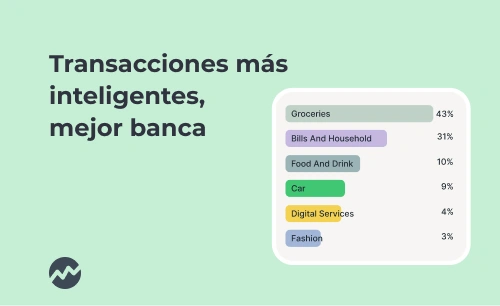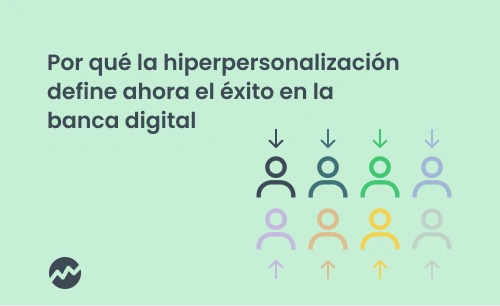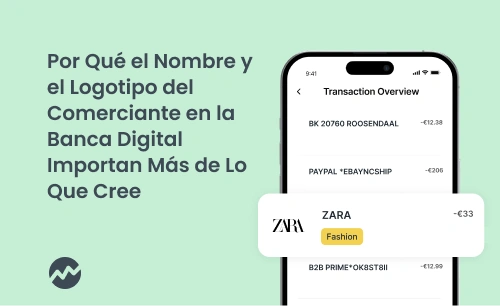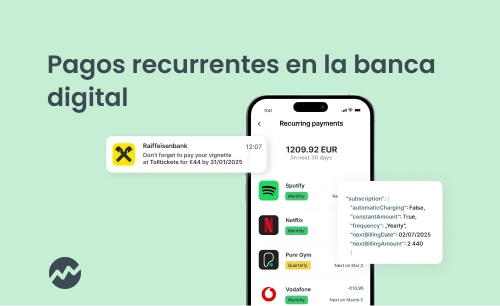
Información del producto
Comunicación bancaria hiperpersonalizada: Convertir los datos en tiempo real en conversaciones de relevancia
La mayoría de las personas pueden saber cuándo un mensaje no estaba realmente destinado a ellos. Un mensaje genérico de tipo «Tenemos una gran oferta para ti» es fácil de ignorar. Los mensajes que reaccionan a lo que una persona está haciendo en realidad esta semana, esta mañana, o incluso a veces este minuto se perciben de manera diferente. Parecen ser útiles.

Información del producto
Cómo una categorización más inteligente de las transacciones abre la puerta a una mejor banca
The way we handle financial transactions has evolved significantly. Contactless payments, mobile wallets, and digital-only banking apps have redefined what it means to manage money. Despite all the technological progress, many banks still struggle in one important area: categorising transactions effectively. This is essential for almost every digital banking service.

Información del producto
Por Qué la Hiperpersonalización Define Ahora El Éxito en la Banca Digital
Las expectativas de los clientes en el ámbito de la banca digital han evolucionado de manera bastante significativa en los últimos años. Han quedado muy lejos los días en que "Buenos días, Alex" y una sugerencia de ahorro basada en plantillas parecían algo impresionante. Hoy, los consumidores demandan mucho más. Quieren sentirse comprendidos, no solo como titulares de cuentas, sino como personas reales con hábitos financieros complejos, con ambiciones y ansiedades. Es la hora de la hiperpersonalización.

Información del producto
Por Qué el Nombre y el Logotipo del Comerciante en la Banca Digital Importan Más de Lo Que Cree
Está navegando por la aplicación de su banco, tratando de recordar cuál fue ese cargo de 33 euros. La línea dice “ESO PETROL TURDA DEP”. ¿Quizás aquel almuerzo? ¿Un coche compartido? ¿Alguien le ha clonado su tarjeta? Ni idea. Lo busca en Google. Eventualmente, se das por vencido, o lo que es peor, llama al servicio al cliente.

Información del producto
Cómo detectar el juego en la banca digital
A menudo empieza con poca cosa. Un cliente transfiere dinero a su cuenta de Skrill, nada fuera de lo habitual. Una simple transacción en el trasfondo de un día bancario tranquilo. Pero horas después, ese mismo pago se canaliza a un casino en línea, enmascarado por un código de categoría de comerciante genérico. ¿A simple vista? Inocente. ¿Pero, en realidad? Un riesgo potencial.

Información del producto
Pagos recurrentes en la Banca Digital: Cómo pasar del caos a la claridad
Cuanto más digitales nos volvemos, más servicios en línea, suscripciones y pagos recurrentes necesitamos controlar, ya que pasan a ser una parte integral de nuestra vida cotidiana. Desde plataformas de streaming y almacenamiento en la nube hasta cuotas mensuales de gimnasio y pagos de automóviles, todas estas transacciones automatizadas ofrecen comodidad, pero a un precio. Si no disponemos de datos precisos de las transacciones presentados de una forma fácil de usar, su gestión se convierte en un reto financiero, tanto para los consumidores como para las instituciones bancarias.

Información del producto
Cómo deben trabajar los bancos con los datos de las transacciones
Para que cualquier plataforma de banca digital funcione bien, los datos delas transacciones deben ir más allá de una simple lista de pagos. Después detodo, si no puede hacer bien lo que resulta más importante, el resto no tienesentido.

Información del producto
El costo de la inexactitud de los datos en la banca digital
La tecnología continúa avanzando poco a poco y, con ello, los datos estánempezando a ser el corazón de cada transacción, decisión y estrategia dentro dela banca. Ya sea recomendando productos financieros a los usuarios oautomatizando los procesos de toma de decisiones, los bancos confían en losdatos para entender a sus clientes y proporcionar una experiencia siobstáculos.

Información del producto
¿Por qué es importante la mejora de transacciones para ganar la Carrera de la banca digital?
Todos usamos datos mejorados a diario, a menudo sin darnos cuenta. La función de autocompletado de Google, sin ir más lejos, se basa en la mejora de datos para proporcionar a los usuarios una experiencia de búsqueda más inteligente.

Información del producto
Guía de cumplimiento de Mastercard AN4569 para bancos
A principios de 2021, Mastercard introdujo una norma para sus emisores de tarjetas europeos conocida como AN 4569 - Normas Revisadas para la Presentación de Datos Mejorados del Comerciante.

.webp)
.webp)